《化学工程与工艺专业英语》课文翻译
化学工程与工艺专业英语课文翻译
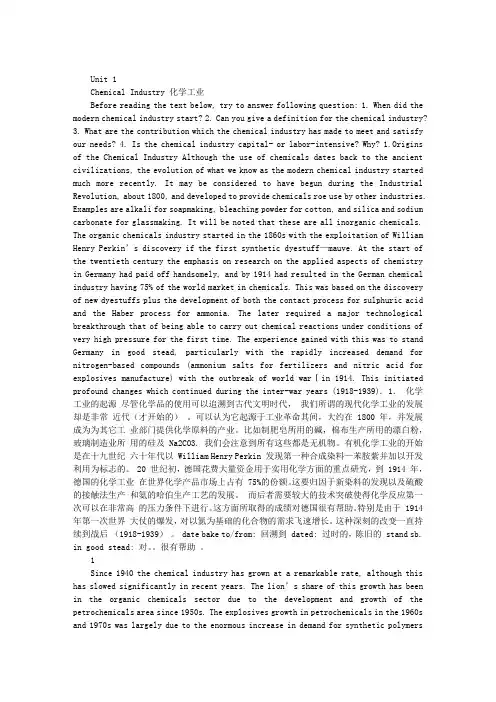
Unit 1Chemical Industry 化学工业Before reading the text below, try to answer following question: 1. When did the modern chemical industry start? 2. Can you give a definition for the chemical industry?3. What are the contribution which the chemical industry has made to meet and satisfy our needs?4. Is the chemical industry capital- or labor-intensive? Why? 1.Origins of the Chemical Industry Although the use of chemicals dates back to the ancient civilizations, the evolution of what we know as the modern chemical industry started much more recently. It may be considered to have begun during the Industrial Revolution, about 1800, and developed to provide chemicals roe use by other industries. Examples are alkali for soapmaking, bleaching powder for cotton, and silica and sodium carbonate for glassmaking. It will be noted that these are all inorganic chemicals. The organic chemicals industry started in the 1860s with the exploitation of William Henry Perkin’s discovery if the first synthetic dyestuff—mauve. At the start of the twentieth century the emphasis on research on the applied aspects of chemistry in Germany had paid off handsomely, and by 1914 had resulted in the German chemical industry having 75% of the world market in chemicals. This was based on the discovery of new dyestuffs plus the development of both the contact process for sulphuric acid and the Haber process for ammonia. The later required a major technological breakthrough that of being able to carry out chemical reactions under conditions of very high pressure for the first time. The experience gained with this was to stand Germany in good stead, particularly with the rapidly increased demand for nitrogen-based compounds (ammonium salts for fertilizers and nitric acid for explosives manufacture) with the outbreak of world warⅠin 1914. This initiated profound changes which continued during the inter-war years (1918-1939). 1.化学工业的起源尽管化学品的使用可以追溯到古代文明时代,我们所谓的现代化学工业的发展却是非常近代(才开始的)。
化学工程与工艺专业英语课文翻译
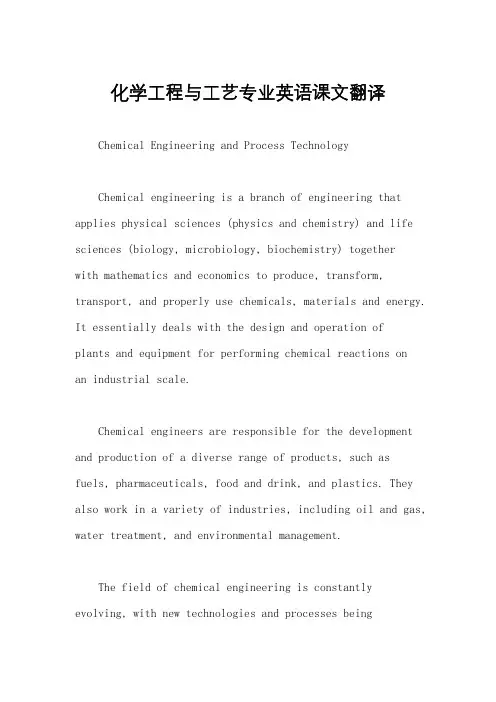
化学工程与工艺专业英语课文翻译Chemical Engineering and Process TechnologyChemical engineering is a branch of engineering that applies physical sciences (physics and chemistry) and life sciences (biology, microbiology, biochemistry) togetherwith mathematics and economics to produce, transform, transport, and properly use chemicals, materials and energy. It essentially deals with the design and operation ofplants and equipment for performing chemical reactions onan industrial scale.Chemical engineers are responsible for the development and production of a diverse range of products, such as fuels, pharmaceuticals, food and drink, and plastics. They also work in a variety of industries, including oil and gas, water treatment, and environmental management.The field of chemical engineering is constantly evolving, with new technologies and processes beingdeveloped to improve efficiency and sustainability. This requires chemical engineers to stay up-to-date with the latest developments in their field and to continually adapt their skills and knowledge.Process technology, on the other hand, focuses on the methods and techniques used to transform raw materials into useful products. This includes the design, operation, and optimization of chemical, physical, and biological processes. Process technologists work closely with chemical engineers to ensure that the processes are efficient, safe, and environmentally friendly.Some of the key areas of study within chemical engineering and process technology include thermodynamics, fluid mechanics, heat transfer, mass transfer, reaction kinetics, process control, and process design. These subjects form the foundation of the discipline and are essential for understanding and solving the complex problems that chemical engineers and process technologists face in their work.In recent years, there has been a growing emphasis on sustainability and green engineering within the field of chemical engineering and process technology. This has led to the development of new processes and technologies that minimize waste, reduce energy consumption, and limit the environmental impact of chemical production.One example of this is the use of renewable feedstocks, such as biomass, in place of traditional fossil fuels. By utilizing sustainable raw materials, chemical engineers and process technologists can help to reduce the reliance on finite resources and decrease the carbon footprint of chemical processes.Another important development in the field is the use of process intensification, which involves the integration of multiple processes into a single, more efficient system. This approach can lead to significant improvements in productivity, energy efficiency, and cost savings.As the demand for chemical products continues to grow, the role of chemical engineers and process technologists inaddressing global challenges, such as climate change and resource depletion, becomes increasingly important. By applying their knowledge and skills to develop innovative and sustainable solutions, they can help to create a more environmentally friendly and economically viable future.In conclusion, chemical engineering and process technology are dynamic and interdisciplinary fields that play a crucial role in the production of a wide range of products. With a focus on sustainability and innovation, chemical engineers and process technologists are well-positioned to address the challenges of the 21st century and contribute to the development of a more sustainable and prosperous world.。
《化学工程与工艺专业英语》课文翻译
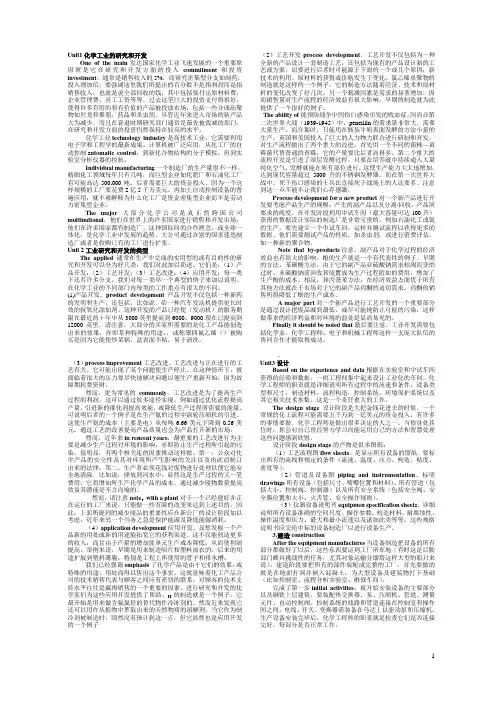
Unit1化学工业的研究和开发One of the main发达国家化学工业飞速发展的一个重要原因就是它在研究和开发方面的投入commitmen t和投资investmen t。
通常是销售收入的5%,而研究密集型分支如制药,投入则加倍。
要强调这里我们所提出的百分数不是指利润而是指销售收入,也就是说全部回收的钱,其中包括要付出原材料费,企业管理费,员工工资等等。
过去这笔巨大的投资支付得很好,使得许多有用的和有价值的产品被投放市场,包括一些合成高聚物如尼龙和聚脂,药品和杀虫剂。
尽管近年来进入市场的新产品大为减少,而且在衰退时期研究部门通常是最先被裁减的部门,在研究和开发方面的投资仍然保持在较高的水平。
化学工业technology industry是高技术工业,它需要利用电子学和工程学的最新成果。
计算机被广泛应用,从化工厂的自动控制a utomatic control,到新化合物结构的分子模拟,再到实验室分析仪器的控制。
Individual manufacturing一个制造厂的生产量很不一样,精细化工领域每年只有几吨,而巨型企业如化肥厂和石油化工厂有可能高达500,000吨。
后者需要巨大的资金投入,因为一个这样规模的工厂要花费2亿5千万美元,再加上自动控制设备的普遍应用,就不难解释为什么化工厂是资金密集型企业而不是劳动力密集型企业。
The major大部分化学公司是真正的跨国公司multinational,他们在世界上的许多国家进行销售和开发市场,他们在许多国家都有制造厂。
这种国际间的合作理念,或全球一体化,是化学工业中发展的趋势。
大公司通过在别的国家建造制造厂或者是收购已有的工厂进行扩张。
Unit 2工业研究和开发的类型The applied通常在生产中完成的实用型的或有目的性的研究和开发可以分为好几类,我们对此加以简述。
它们是:(1)产品开发;(2)工艺开发;(3)工艺改进;(4)应用开发;每一类下还有许多分支。
化工专业英语翻译(全21单元)
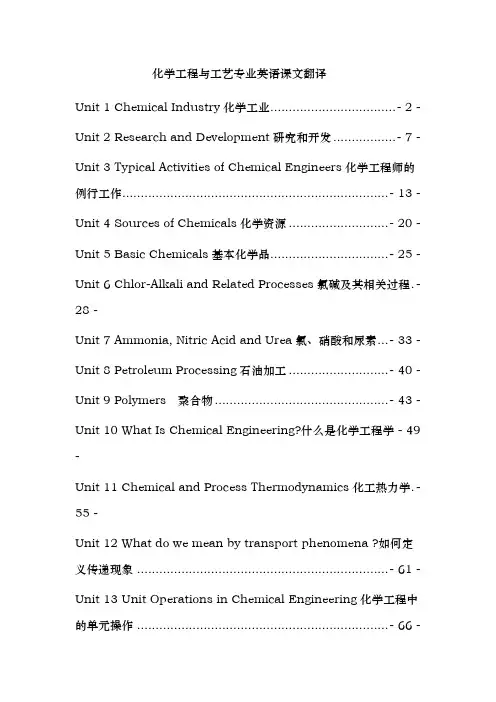
化学工程与工艺专业英语课文翻译Unit 1 Chemical Industry化学工业.................................. - 2 - Unit 2 Research and Development研究和开发................. - 7 - Unit 3 Typical Activities of Chemical Engineers化学工程师的例行工作........................................................................ - 13 - Unit 4 Sources of Chemicals化学资源........................... - 20 - Unit 5 Basic Chemicals基本化学品................................ - 25 - Unit 6 Chlor-Alkali and Related Processes氯碱及其相关过程.- 28 -Unit 7 Ammonia, Nitric Acid and Urea氯、硝酸和尿素... - 33 - Unit 8 Petroleum Processing石油加工........................... - 40 - Unit 9 Polymers 聚合物............................................... - 43 - Unit 10 What Is Chemical Engineering?什么是化学工程学 - 49 -Unit 11 Chemical and Process Thermodynamics化工热力学.- 55 -Unit 12 What do we mean by transport phenomena ?如何定义传递现象 .................................................................... - 61 - Unit 13 Unit Operations in Chemical Engineering化学工程中的单元操作 .................................................................... - 66 -Unit14 Distillation蒸馏................................................. - 70 - Unit 15 Solvent Extraction, Leaching and Adsorption溶剂萃取,浸取和吸附 .............................................................. - 75 - Unit 16 Evaporation, Crystallization and Drying蒸发、结晶和干燥.............................................................................. - 81 - Unit 17 Chemical Reaction Engineering化学反应工程.... - 88 - Unit18 Chemical Engineering Modeling化工建模 .......... - 95 - Unit 19 Introduction to Process Design过程设计简介 .... - 99 - Unit 20 Material Science and Chemical Engineer材料科学和化学工程...................................................................... - 105 - Unit 21 Chemical Industry and Environment化学工业与环境-111 -Unit 1 Chemical Industry化学工业1.化学工业的起源尽管化学品的使用可以追溯到古代文明时代,我们所谓的现代化学工业的发展却是非常近代(才开始的)。
《化学工程与工艺专业英语》最全翻译最新整理
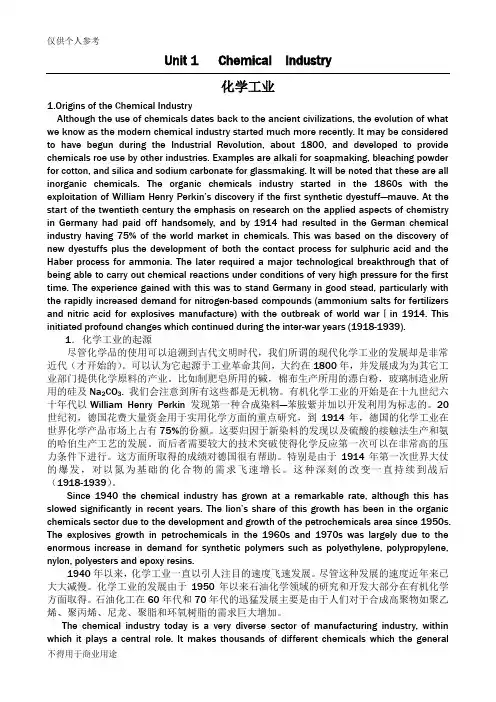
Unit 1 Chemical Industry化学工业1.Origins of the Chemical IndustryAlthough the use of chemicals dates back to the ancient civilizations, the evolution of what we know as the modern chemical industry started much more recently. It may be considered to have begun during the Industrial Revolution, about 1800, and developed to provide chemicals roe use by other industries. Examples are alkali for soapmaking, bleaching powder for cotton, and silica and sodium carbonate for glassmaking. It will be noted that these are all inorganic chemicals. The organic chemicals industry started in the 1860s with the exploitation of William Henry Perkin’s discovery if the first synthetic dyestuff—mauve. At the start of the twentieth century the emphasis on research on the applied aspects of chemistry in Germany had paid off handsomely, and by 1914 had resulted in the German chemical industry having 75% of the world market in chemicals. This was based on the discovery of new dyestuffs plus the development of both the contact process for sulphuric acid and the Haber process for ammonia. The later required a major technological breakthrough that of being able to carry out chemical reactions under conditions of very high pressure for the first time. The experience gained with this was to stand Germany in good stead, particularly with the rapidly increased demand for nitrogen-based compounds (ammonium salts for fertilizers and nitric acid for explosives manufacture) with the outbreak of world warⅠin 1914. This initiated profound changes which continued during the inter-war years (1918-1939).1.化学工业的起源尽管化学品的使用可以追溯到古代文明时代,我们所谓的现代化学工业的发展却是非常近代(才开始的)。
《化学工程与工艺专业英语》课文翻译-Unit 3 Typical Activities of Chemical Engineers
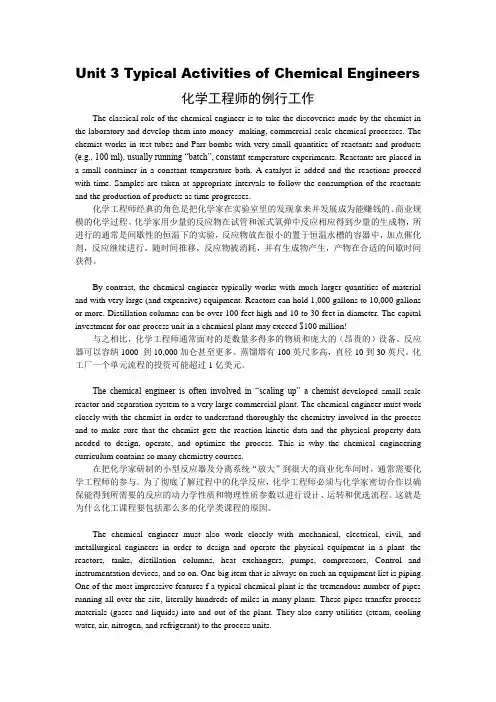
Unit 3 Typical Activities of Chemical Engineers化学工程师的例行工作The classical role of the chemical engineer is to take the discoveries made by the chemist in the laboratory and develop them into money--making, commercial-scale chemical processes. The chemist works in test tubes and Parr bombs with very small quantities of reactants and products (e.g., 100 ml), usually running “batch”, constant-temperature experiments. Reactants are placed in a small container in a constant temperature bath. A catalyst is added and the reactions proceed with time. Samples are taken at appropriate intervals to follow the consumption of the reactants and the production of products as time progresses.化学工程师经典的角色是把化学家在实验室里的发现拿来并发展成为能赚钱的、商业规模的化学过程。
化学家用少量的反应物在试管和派式氧弹中反应相应得到少量的生成物,所进行的通常是间歇性的恒温下的实验,反应物放在很小的置于恒温水槽的容器中,加点催化剂,反应继续进行,随时间推移,反应物被消耗,并有生成物产生,产物在合适的间歇时间获得。
《化学工程与工艺专业英语》课文翻译Unit 20 Material Science and Chemical Engineering
Unit 20 Material Science and ChemicalEngineering材料科学和化学工程A few years ago, who would have dreamed that an aircraft could circumnavigate the earth without landing or refueling? Yet in 1986 the novel aircraft V oyager did just that. The secret of V oyager’s long flight lies in advanced materials that did not exist a few years ago. Much of the airframe was constructed from strong, lightweight polymer-fiber composite sections assembled with durable, high-strength adhesive; the engine was lubricated with a synthetic multicomponent liquid designed to maintain lubricity for a long time under continuous operation. These special materials typify the advances being made by scientists and engineers to meet the demands of modern society.几年以前,谁会想到一架飞机可以绕地球航行而中途不需要着陆或添加燃料?而在1986年新型的飞机航海者就做到了这一点。
航海者具备长途飞行能力的秘密就在于几年前还没有出现的先进的材料。
最新化工专业英语翻译(全21单元)01620资料
化学工程与工艺专业英语课文翻译Unit 1 Chemical Industry化学工业 ...................................................................................... - 1 -Unit 2 Research and Development研究和开发................................................................... - 3 -Unit 3 Typical Activities of Chemical Engineers化学工程师的例行工作............................ - 5 -Unit 4 Sources of Chemicals化学资源 ................................................................................. - 7 -Unit 5 Basic Chemicals基本化学品...................................................................................... - 9 -Unit 6 Chlor-Alkali and Related Processes氯碱及其相关过程.......................................... - 10 -Unit 7 Ammonia, Nitric Acid and Urea氯、硝酸和尿素 ................................................... - 12 -Unit 8 Petroleum Processing石油加工 .............................................................................. - 15 -Unit 9 Polymers 聚合物 ................................................................................................... - 16 -Unit 10 What Is Chemical Engineering?什么是化学工程学 .............................................. - 18 -Unit 11 Chemical and Process Thermodynamics化工热力学 ........................................... - 21 -Unit 12 What do we mean by transport phenomena ?如何定义传递现象 ...................... - 23 -Unit 13 Unit Operations in Chemical Engineering化学工程中的单元操作...................... - 24 -Unit14 Distillation蒸馏....................................................................................................... - 26 -Unit 15 Solvent Extraction, Leaching and Adsorption溶剂萃取,浸取和吸附................ - 28 -Unit 16 Evaporation, Crystallization and Drying蒸发、结晶和干燥................................. - 31 -Unit 17 Chemical Reaction Engineering化学反应工程 ..................................................... - 33 -Unit18 Chemical Engineering Modeling化工建模 ............................................................. - 36 -Unit 19 Introduction to Process Design过程设计简介...................................................... - 37 -Unit 20 Material Science and Chemical Engineer材料科学和化学工程........................... - 39 -Unit 21 Chemical Industry and Environment化学工业与环境 ......................................... - 42 -Unit 1 Chemical Industry化学工业1.化学工业的起源尽管化学品的使用可以追溯到古代文明时代,我们所谓的现代化学工业的发展却是非常近代(才开始的)。
《化学工程与工艺专业英语》课文翻译-Unit 3 Typical Activities of Che
《化学工程与工艺专业英语》课文翻译-Unit3 Typical Activities of ChemicalEngineers本文将介绍化学工程师在日常工作中的一些典型活动。
化学工程师旨在将化学与工程学的原理应用于产业中,解决生产过程中的各种问题并开发新产品。
化学工程师随着技术的发展和市场的变化而发展和变化。
但以下是其典型活动:第一,设计新的工艺流程。
化学工程师需要了解化学反应原理、物质转化和热量传递方程式,以及流体力学和系统分析等方面的知识,创造出新的工艺流程。
在此基础上,他们可以设计出化学反应器、分离装置和加工设备等。
而在设计之前,化学工程师会根据产品需求和工厂生产线等因素,制定经济可行性和技术可行性分析,制定整个流程方案。
第二,工厂的设计和规划。
这些安装要求使用化学工程师的技能和知识。
工程师需要考虑由工厂所需的供电、供水和废物处理等各个方面。
他们需要选择合适的材料和设备,也需要在设计中采用节能和环境保护技术。
他们也必须为紧密的安全要求和法律法规做好准备。
第三,处理产品的生产和质量控制。
生产线上的任何错误都有可能导致生产过程劣化和生产失败。
化学工程师通过控制生产过程的不同参数和调整生产中的机器设备、材料流程和成品质量保障等,确保产品的质量和产品的性能。
如果有任何生产上的问题,他们都需要快速响应,并及时寻找解决方法。
第四,进行研究和开发。
在工业生产中,研究和开发是至关重要的。
化学工程师必须熟悉当前和未来的技术发展。
他们需要收集和分析大量的数据和材料,以探索和开发新的技术和产品,面对多种工艺流程,为生产线输入新的元素。
第五,进行销售和市场分析。
销售和市场分析也是化学工程师需要了解的另一个方面。
他们需要熟悉市场需求和市场潜力。
工程师必须在市场竞争激烈的环境中发挥创新、争取同行的业务和合作伙伴,为他们的产品寻找最佳销售渠道。
第六,维护和管理设备。
对于工厂设备的维护和管理是保证生产线平稳运转的必要条件。
(完整word)《化学工程与工艺专业英语》课文翻译
Unit 1 Chemical Industry化学工业1.Origins of the Chemical IndustryAlthough the use of chemicals dates back to the ancient civilizations, the evolution of what we know as the modern chemical industry started much more recently. It may be considered to have begun during the Industrial Revolution, about 1800, and developed to provide chemicals roe use by other industries。
Examples are alkali for soapmaking, bleaching powder for cotton, and silica and sodium carbonate for glassmaking。
It will be noted that these are all inorganic chemicals. The organic chemicals industry started in the 1860s with the exploitation of William Henry Perkin’s discovery if the first synthetic dyestuff—mauve. At the start of the twentieth century the emphasis on research on the applied aspects of chemistry in Germany had paid off handsomely, and by 1914 had resulted in the German chemical industry having 75% of the world market in chemicals. This was based on the discovery of new dyestuffs plus the development of both the contact process for sulphuric acid and the Haber process for ammonia。
- 1、下载文档前请自行甄别文档内容的完整性,平台不提供额外的编辑、内容补充、找答案等附加服务。
- 2、"仅部分预览"的文档,不可在线预览部分如存在完整性等问题,可反馈申请退款(可完整预览的文档不适用该条件!)。
- 3、如文档侵犯您的权益,请联系客服反馈,我们会尽快为您处理(人工客服工作时间:9:00-18:30)。
Unit 1 Chemical Industry化学工业1.Origins of the Chemical IndustryAlthough the use of chemicals dates back to the ancient civilizations, the evolution of what we know as the modern chemical industry started much more recently. It may be considered to have begun during the Industrial Revolution, about 1800, and developed to provide chemicals roe use by other industries. Examples are alkali for soapmaking, bleaching powder for cotton, and silica and sodium carbonate for glassmaking. It will be noted that these are all inorganic chemicals. The organic chemicals industry started in the 1860s with the exploitation of William Henry Perkin‘s discovery if the first synthetic dyestuff—mauve. At the start of the twentieth century the emphasis on research on the applied aspects of chemistry in Germany had paid off handsomely, and by 1914 had resulted in the German chemical industry having 75% of the world market in chemicals. This was based on the discovery of new dyestuffs plus the development of both the contact process for sulphuric acid and the Haber process for ammonia. The later required a major technological breakthrough that of being able to carry out chemical reactions under conditions of very high pressure for the first time. The experience gained with this was to stand Germany in good stead, particularly with the rapidly increased demand for nitrogen-based compounds (ammonium salts for fertilizers and nitric acid for explosives manufacture) with the outbreak of world warⅠin 1914. This initiated profound changes which continued during the inter-war years (1918-1939).1.化学工业的起源尽管化学品的使用可以追溯到古代文明时代,我们所谓的现代化学工业的发展却是非常近代(才开始的)。
可以认为它起源于工业革命其间,大约在1800年,并发展成为为其它工业部门提供化学原料的产业。
比如制肥皂所用的碱,棉布生产所用的漂白粉,玻璃制造业所用的硅及Na2CO3. 我们会注意到所有这些都是无机物。
有机化学工业的开始是在十九世纪六十年代以William Henry Perkin 发现第一种合成染料—苯胺紫并加以开发利用为标志的。
20世纪初,德国花费大量资金用于实用化学方面的重点研究,到1914年,德国的化学工业在世界化学产品市场上占有75%的份额。
这要归因于新染料的发现以及硫酸的接触法生产和氨的哈伯生产工艺的发展。
而后者需要较大的技术突破使得化学反应第一次可以在非常高的压力条件下进行。
这方面所取得的成绩对德国很有帮助。
特别是由于1914年第一次世界大仗的爆发,对以氮为基础的化合物的需求飞速增长。
这种深刻的改变一直持续到战后(1918-1939)。
date bake to/from: 回溯到dated: 过时的,陈旧的stand sb. in good stead: 对。
很有帮助Since 1940 the chemical industry has grown at a remarkable rate, although this has slowed significantly in recent years. The lion‘s share of this growth has been in the organic chemicals sector due to the development and growth of the petrochemicals area since 1950s. The explosives growth in petrochemicals in the 1960s and 1970s was largely due to the enormous increase in demand for synthetic polymers such as polyethylene, polypropylene, nylon, polyesters and epoxy resins.1940年以来,化学工业一直以引人注目的速度飞速发展。
尽管这种发展的速度近年来已大大减慢。
化学工业的发展由于1950年以来石油化学领域的研究和开发大部分在有机化学方面取得。
石油化工在60年代和70年代的迅猛发展主要是由于人们对于合成高聚物如聚乙烯、聚丙烯、尼龙、聚脂和环氧树脂的需求巨大增加。
The chemical industry today is a very diverse sector of manufacturing industry, within which it plays a central role. It makes thousands of different chemicals which the general public only usually encounter as end or consumer products. These products are purchased because they have the required properties which make them suitable for some particular application, e.g. a non-stick coating for pans or a weedkiller. Thus chemicals are ultimately sold for the effects that they produce.今天的化学工业已经是制造业中有着许多分支的部门,并且在制造业中起着核心的作用。
它生产了数千种不同的化学产品,而人们通常只接触到终端产品或消费品。
这些产品被购买是因为他们具有某些性质适合(人们)的一些特别的用途,例如,用于盆的不粘涂层或一种杀虫剂。
这些化学产品归根到底是由于它们能产生的作用而被购买的。
2. Definition of the Chemical IndustryAt the turn of the century there would have been little difficulty in defining what constituted the chemical industry since only a very limited range of products was manufactured and these were clearly chemicals, e.g., alkali, sulphuric acid. At present, however, many intermediates to products produced, from raw materials like crude oil through (in some cases) many intermediates to products which may be used directly as consumer goods, or readily converted into them. The difficulty cones in deciding at which point in this sequence the particular operation ceases to be part of the chemical industry‘s sphere of activities. To consider a specific example to illustrate thi s dilemma, emulsion paints may contain poly (vinyl chloride) / poly (vinyl acetate). Clearly, synthesis of vinyl chloride (or acetate) and its polymerization are chemical activities. However, if formulation and mixing of the paint, including the polymer, is carried out by a branch of the multinational chemical company which manufactured the ingredients, is this still part of the chemical industry of does it mow belong in the decorating industry?2.化学工业的定义在本世纪初,要定义什么是化学工业是不太困难的,因为那时所生产的化学品是很有限的,而且是非常清楚的化学品,例如,烧碱,硫酸。
